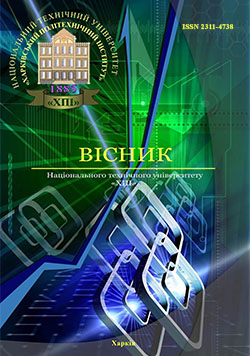MATRIX MODEL 4R & WS FOR THE CLASSIFICATION OF THE PROJECT STAKEHOLDERS
DOI:
https://doi.org/10.20998/2413-3000.2017.1224.3Keywords:
interested parties, stakeholders, identification, classification, project.Abstract
A model for the classification of project stakeholders, which establishes interrelation between the individual characteristics of the project (risks, works, resources, requirements, stakeholders and responsible persons of the project - 4R & WS) using a Work Breakdown Structure is proposed. A conceptual model of stakeholders identification in the form of the 4R & WS cube is proposed. The proposed model makes it possible to monitor the dynamics of the project and identifies the stakeholders of the project in directions of the 4R & WS model. A classification of project stakeholders will provide information on the resource and risk load of specific stakeholder’s requirements that will enable more considered planning of engagement strategy of stakeholders and management of project stakeholders’ requirements.
References
1. Horkoff J., Yu E. Interactive goal model analysis for early requirements engineering. Requirements Engineering. 2014, no. 21 (1), pp. 29–61. doi: 10.1007/s00766-014-0209-8.
2. Ramadan N., Megahed S. Requirements Engineering in Scrum Framework. International Journal of Computer Applications. 2016, no. 149 (8), pp. 24–29. doi: 10.5120/ijca2016911530.
3. Kotonya G, Sommerville I, Requirements Engineering: Processes and Techniques. John Wiley & Sons, 1998. 294 p.
4. Chemuturi M. Requirements Engineering and Management for Software Development Projects. 2013. 266 p. doi: 10.1007/978-1-4614-5377-2.
5. Miranda E.Time boxing planning: Buffered Moscow Rules. ACM SIGSOFT Software Engineering Notes. 2011, no. 36 (6), pp. 1–5. doi: 0.1145/2047414.2047428.
6. Kadykova I. M., Larina S. O., Chumachenko I. V. Upravlinnya vnutrishnimy steykkholderamy proektiv pry realizatsiyi stratehiyi prohramy [Managing internal project stakeholders in the implementation strategy of the program]. Upravlinnya rozvytkom skladnykh system [Managing the development of complex systems]. 2016, no. 28, pp. 47–53.
7. A Guide to the Project Management Body of Knowledge (PMBOK® Guide). 5th ed. Newtown Square, Pa.: Project Management Institute, Inc., 2013. 614 p. doi.org/10.1002/pmj.21345
8. Davydov, D. M. K voprosu o metodakh klassifikatsii zainteresovannykh storon [On the question of the methods of stakeholders classification]. Aktual'nye problemy upravleniya [Actual problems of management]. 2015, no. 2, pp. 141–147.
9. Petrov M. A. Teorija zainteresovannyh storon: puti prakticheskogo primenenija [Stakeholder theory: the practical application]. Vestnik SPbGU. Ser. 8. 2004, no. 16, pр. 51–68.
10. A Guide To The Business Analysis Body Of Knowledge. 3rd ed. IIBA, 2015. 657 p.
11. Husyeva Yu. Yu., Chumachenko I. V., Sydorenko M. V. Upravlinnya zatsikavlenymy storonamy osvitnikh proektiv [Managing stakeholder education projects]. Visnyk NTU «KhPI». Ser : Stratehichne upravlinnya, upravlinnya portfelyamy, prohramamy ta proektamy [Bulletin NTU "KPI". Ser : Strategic management, portfolio management, program and project]. 2016, no. 2 (1174), pp. 8–12. doi: 10.20998/2413-3000.2016.1174.2.
12. Husyeva Yu. Yu., Martynenko O. S., Chumachenko, I.V. Protsesnyy pidkhid do modelyuvannya i monitorynhu vymoh zatsikavlenykh storin [Process approach to modeling and monitoring requirements of stakeholders]. Informatsiyni tekhnolohiyi ta innovatsiyi v ekonomitsi, upravlinni proektamy ta prohramamy [Information technology and innovation in the economy, Program and Project Management]. 2016, pp. 289–296.
Downloads
Published
Issue
Section
License
Copyright (c) 2017 Юлія Юріївна ГУСЄВА, Олександр Сергійович МАРТИНЕНКО, Ігор Володимирович ЧУМАЧЕНКО

This work is licensed under a Creative Commons Attribution-NonCommercial-ShareAlike 4.0 International License.
Our journal abides by the Creative Commons copyright rights and permissions for open access journals.
Authors who publish with this journal agree to the following terms:
Authors hold the copyright without restrictions and grant the journal right of first publication with the work simultaneously licensed under a Creative Commons Attribution-NonCommercial-ShareAlike 4.0 International License (CC BY-NC-SA 4.0) that allows others to share the work with an acknowledgement of the work's authorship and initial publication in this journal.
Authors are able to enter into separate, additional contractual arrangements for the non-commercial and non-exclusive distribution of the journal's published version of the work (e.g., post it to an institutional repository or publish it in a book), with an acknowledgement of its initial publication in this journal.
Authors are permitted and encouraged to post their published work online (e.g., in institutional repositories or on their website) as it can lead to productive exchanges, as well as earlier and greater citation of published work.

